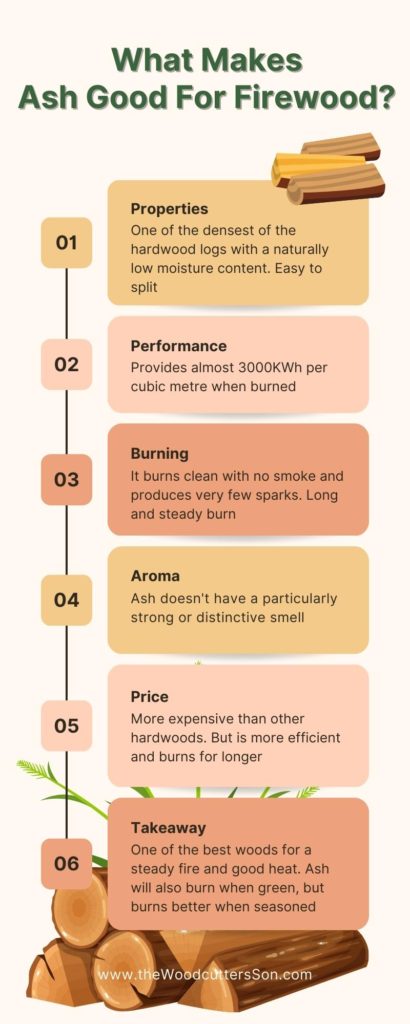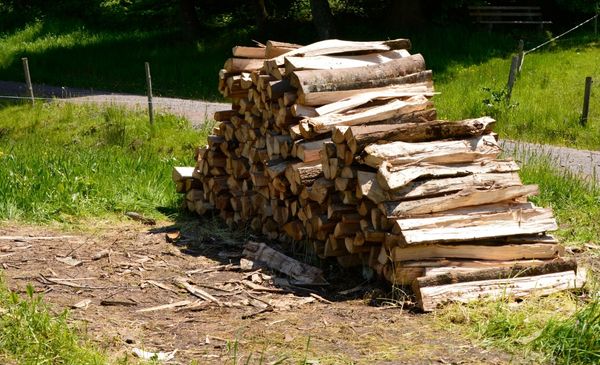If you’re looking to enjoy warm and cozy evenings by the fireplace this winter, you’ll need to select the right type of firewood. But with so many varieties out there, it can be tricky to decide which is best for your needs.
In this article, we’re taking a look at the best firewood for your stove – specifically, whether ash wood is a good choice.
First, let’s have a look at some of the most common types of firewood: maple, birch, cedar, elm, pine, poplar, cottonwood, sycamore walnut, locust, black walnut, hackberry and mulberry.
We’ll discuss some of their key characteristics and the kind of burning experience each provides. Finally, we’ll see if ash really is the best choice for keeping your stove burning all night long. So grab your mug of hot cocoa and let’s dive in!
TABLE OF CONTENTS:
Is Ash Good Firewood?
When it comes to choosing the right firewood for your stove, you might be wondering if ash is a good choice. Before we get into if ash is a good firewood, let’s talk about the basics: what is ash?
Ash, or ‘Fraxinus spp’, is considered one of the best wood fuel species for burning since it has a high BTU rating per volume. Its heavy weight and high heat output make it ideal for long burns that are hot enough to dry out other kinds of wood.
If you’re looking for an easy-to-source firewood with less smoke than most types of wood and a high efficiency rating, ash might be your answer. Plus, ash trees are common in many parts of North America and Europe, so the wood should be available in many places near you.
What makes Ash good for firewood? – [Infographic]

Burning Maple, Birch, Cedar, and Elm Firewood
When it comes to burning firewood, maple, birch, cedar, and elm can all be excellent choices. Maple is a hardwood that burns slowly and produces a warm, comfortable heat. It’s easy to light and helps keep your fire going for several hours when added to the mix.
Birch is also a hardwood that produces good heat, but burns quickly so keep it in mind when rationing your wood supply. Cedar has a pleasant smell and is great for campfires and fireside chats due to its low flame height.
Elm is also a good choice for stoves; it’s easy to light and provides both heat and aroma.
Related Article: Outdoor firewood storage ideas
The Pros and Cons of Pine, Poplar, Cottonwood and Sycamore
If you’re considering using pine, poplar, cottonwood or sycamore for your firewood needs, here are some pros and cons to consider.
Is Pine good firewood?
Pine is generally a lighter wood, and one of the most common types of firewood. It’s easy to find, although it can be difficult to split due to its density. It burns gradually and produces a nice scent while burning.
On the downside, pine produces little heat compared to other varieties of hardwood, so don’t expect it to keep your fireplace warm for long.
Is Poplar good firewood?
Poplar is another common choice when looking for firewood. It’s lightweight and easy to cut, split and stack for storage. It also burns well in fireplaces because produces lots of smokeless heat that lasts a long time.
However, it doesn’t have much aroma or flavor and will cause creosote build-up in your chimney much faster than other hardwoods do.
Is Cottonwood good firewood?
Cottonwood is not typically used as firewood because it burns fast with little heat output due to its lower density and high moisture content. On the upside, cottonwood is relatively easy to chop down into logs which makes storing the wood convenient and efficient.
However, due to its quick-burning nature it should be used sparingly or mixed with other hardwoods that have higher burning temperatures like maple or oak.
Is Sycamore good firewood?
Sycamore has similar benefits as poplar — it’s lightweight and doesn’t require much effort when cutting or splitting — but provides a bit more heat over time than poplar does.
Unfortunately, sycamore can cause lots of creosote build-up.
Related Article: How to season firewood

Is Walnut the Best Choice for Your Stove?
If you’re looking for the absolute best firewood for your stove, walnut is one of the top choices. Not only is Walnut wood one of the densest and heaviest woods available, but it also burns more slowly and with more heat.
Walnut also has a pleasant smell when it burns, making it an ideal choice for those who want to add a pleasant aroma to their home while keeping warm. Walnut also has some other benefits:
- Walnut can be cut smaller than other woods, so you’ll get more usable material out of each log.
- Walnut wood is strong and dense, so it will burn hot and slow.
- It burns cleanly with minimal smoke or creosote build-up; in fact, walnut doesn’t produce any smoke at all unless it’s under-seasoned or damp.
- Unlike some other woods such as pine, walnut won’t spark in your stove as much as other hardwoods, so it won’t present any additional fire hazard in your home.
Examining Locust, Black Walnut, Hackberry and Mulberry
Let’s take a closer look at some of the less common but still potential options for firewood, such as locust, black walnut, hackberry, and mulberry. All of these woods are generally considered to be good firewood with some pros and cons.
Is Locust good firewood?
Locust is known for its strength and stability, so you can expect it to burn fairly hot and put off consistent heat for a longer period of time compared to some other woods.
However, locust wood is also very dense which means it takes longer to burn completely and can be difficult to ignite.
Is Black Walnut good firewood?
Black walnut is often praised for its unique aroma and flavor when used in smoking or grilling applications. However, when used as firewood it can take a while to get going and won’t burn as hot as some other options like oak or hickory.
Is Hackberry good firewood?
Hackberry is widely available throughout North America and can be burned regardless of whether it’s green or dry. Again, it’s not the hottest burning wood (it won’t reach the temperatures that oak will reach) but it does produce a decent amount of heat if given enough time.
Is Mulberry good firewood?
Mulberry has an average BTU rating but burns slow so you don’t have to refuel your fire every 45 minutes or so like you do with other woods like birch or maple.
Mulberry also tends to smoke more than other woods so be sure that the area you’re burning in has enough ventilation to disperse the smoke safely.
Conclusion
All in all, there are a variety of wood types that make great firewood, and some are better suited to certain types of stoves. Ash is a good choice if you’re looking for a wood that produces an even heat, burns slowly, and has low smoke and spark production.
However, it won’t last as long as some of the other choices. Maple, birch, cedar, elm, pine, poplar, cottonwood, sycamore, walnut, locust, black walnut, hackberry, and mulberry all make good firewood depending on the type of stove and your particular burning needs.
Consider the points made in this article and pick the wood that works best for you!

Leave a Reply